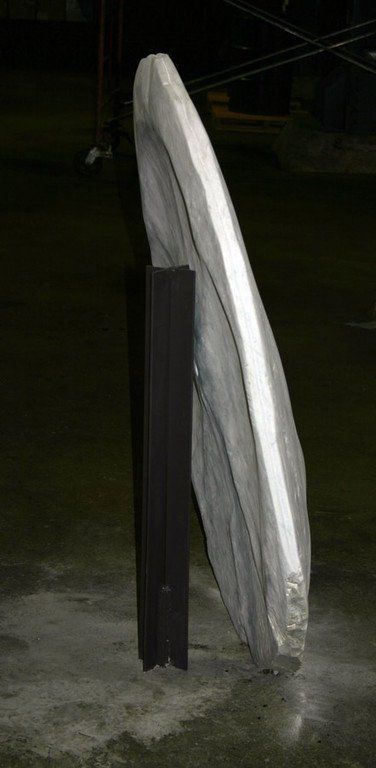white Shield, 1998-1999
In the collection of the Art Gallery of Nova Scotia, Halifax, NS Canada
Italian marble, steel stand; 41” x 51” x 10” ( 105 x 130 x 25 cm)
It is a shield-like shape that is based on the investigation of a sand-dollar as an object. The white shield is carved in white Italian Marble and is about 105 x 130 x 25 cm in size. I was working on this piece parallel to the "shield"-drawings. Initially I thought about having a large shield cast in bronze and finish it with a white patina. Yet as I started to think about its significance in regard to the human body, I decided to carve it out of white stone. To me - bronze as material would imply a strong connection to the earth (in reference to its coming into existence through a liquid stage and its mineral consistency), as well an element of sound would have been involved, which I did not want. Last but not least, it would refer to cultural artifacts, shields that were manufactured as armament. My shield is not meant to be seen as an instrument in service of the human body, moreover, the relationship that I am seeking in that piece is meant to be an experience with a thing as an identity.
The white, standing shield in stone reflects clearly on our uprightness. It relates to the body - a walking element in space - as a standing/resting counterpart.
Like a body, the shield embraces space; from the front and the back it is large and massive, yet if you look at it from the side, it has an intimate size. Intrinsically to the shape is, that it has to be held upright. It has to lean against something which indicates a rest, a balance as well as a potential for relocation. In connection to a purposefully constructed stand this emphasizes the inherent duality of the shape; it is a large and heavy piece, yet not meant to be seen stable in its position.
It has a front and a back and comparable to what I described for the maquette for Reflection/Shield - the form has an edge that is incised by a groove. It bears a finger-size hole just above the center of its back.
The division-line is not continued around the bottom edge, yet surrounds the piece in order to emphasize the "touching" of two elements, the embrace of an inner space.
see also: Sculpture MFA thesis exhibition at NSCAD University, Halifax, NS Canada
In der Sammlung der Art Gallery of Nova Scotia, Halifax, NS Kanada
Italienischer Marmor, Stahlständer; 105 x 130 x 25 cm
"White Shield" ist eine schildähnliche Form, die sich auf die Untersuchung eines Sanddollars als Objekt stützt. Die Skulptur ist in weißem Marmor gearbeitet und misst 105 x 130 x 25 cm. Ich arbeitete an diesem Werk parallel zu den "shields"-Zeichnungen. Zunächst dachte ich darüber nach, ein großes Schild in Bronze zu gießen und es mit einer weißen Patina zu behandeln. Als ich aber begann, über seine Bedeutung in Bezug auf den menschliche Körper nachzudenken, entschied ich mich dafür, es aus weißem Marmor zu schlagen. Bronze würde für mich eine enge Verbindung zur Erde bedeuten (dies in Verbindung zum Prozess des Bronzegusses durch einen flüssigen Zustand und der Konsistenz eines Minerals).Außerdem wäre eine Element des Klanges vorhanden und ich wollte dies nicht. Letztendlich bedeutete Bronze einen zu starken Bezug auf kulturelle Artefakte, Schilde die als Teil einer Rüstung hergestellt wurden.
Mein "Shield" sollte nicht als Instrument im Dienste des menschlichen Körpers angesehen werden, vielmehr suche ich mit dieser Arbeit ein Verhältnis, das einer Erfahrung mit einem "Ding" als Identität gleichkommt. Das weiße, stehende Schild relfektiert unsere aufrechte Haltung. Es bezieht sich auf unseren Körper, ein sich bewegendes Element im Raum, als ein stehendes, sich in Ruhe befindendes Gegenstück.
Wie ein Körper umschließt das Schild Raum; von vorne und hinten ist es groß und massiv, von der Seite betrachtet ist die Größe eher intim und privat. Verkörpert in der Form ist, dass sie aufrecht gehalten werden muss. Es muss gegen etwas gelehnt werden, was Ruhe vermittelt, ein Gleichgewicht, aber auch das Potential für eine Versetzung. In Verbindung mit einem speziell konstruierten Ständer betont dies die enthaltene Dualität der Form; es ist eine relativ große und stabile, schwere Arbeit, die nicht als stabil in ihrer Positionierung angesehen werden soll.
Die Form hat ein Vorne und ein Hinten und die Kante ist durch eine Furche, eine Falte gekennzeichnet. Auf der Rückseite befindet sich ein fingergroßes Loch, direkt oberhalb des Mittelpunktes der Form. Die Trennungslinie der Kante ist nicht durchgehend an der Unterkante, umschließt aber trotzdem die Form, so dass ein "sich Berühren" von zwei Teilen betont wird, eine Umschließung eines inneren Raumes.








